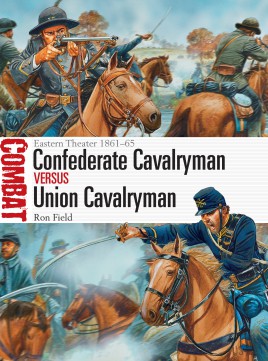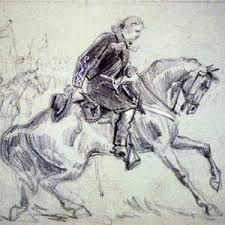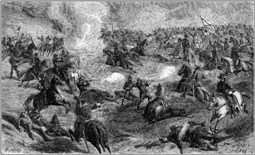Review: Steampunk History – Osprey’s Confederate Cavalryman versus Union Cavalryman

Leather duster, shotgun… sword and lance. That’s pretty much an iconic Steampunk image, but it’s also a Confederate Cavalryman, which is why I asked Osprey to send me a review copy of their Confederate Cavalryman vs Union Cavalryman – Eastern Theater 1861-65 (Combat) – I am these days at least a 50% Steampunk author, after all.
I was expecting insights into what happens when “modern” Victorian cavalry armies clash. I got that, but also a sense of what cavalry warfare feels like in any era where cold steel and raw courage grant victory as much as good tactics and drill.
To an outsider, the American Civil War looks like oddly like a backwards version of World War One. Both were continental scale wars between belligerents who shared a civilisation. Both resulted from convoluted strings of decisions made with more enthusiasm for honour and principle than for preserving the lives of young men. However, during the course of the fighting, the Civil War gained moral purpose — became about slavery– whereas the Great War lost it — became about… well mostly mud, with the real crusades being internal, classically the development of tanks by both sides.
What’s interesting — to the same outsider — is that the American Civil War, unlike World War One, routinely had massed cavalry battles.
The up-to-date 1860s armory is not so different from the 1914 one except in terms of refinement: we have repeating rifles, revolvers, and shotguns that would all have served adequately in Flanders. However we don’t yet have proper machine guns, meaning that cavalry is still practical; not just practical but vital in wars between “modern” western-style armies.
And that’s what this book covers: three significant engagements in the Eastern Theatre: Lewis Ford, Buckland Mills and Tom’s Brook, plus the equipment, logistics, organisation and tactics.

It paints a picture of an equally unequal struggle.
The Confederates are good horsemen, almost bred to be cavalry, and the army’s organization reflects it. The Federals – that term used to confuse me – are much poorer horse soldiers, and — in a ironic parallel with the history of tanks — it takes forever for Cavalry to be treated as an arm in its own right.
However, the Confederates are under-resourced to the point of being institutionally medieval. Men provide their own mounts, ride to war with their own weapons, increasingly in civilian clothes, in regiments raised by landlords and local big men, and supplement their equipment with looted Union kit. The Union meanwhile has resources, and ultimately time, on its side.
So it is that at Lewis Ford we have the Confederates sweeping the Union Cavalry from the field, doing it again at Buckland Mills, then getting swamped at Tom’s Brook.
Along the way, we get some breathtaking moments where the very centuries seem to clash: Confederate cavalry ploughing into a stationary Union unit, the latter trying to see off the charge by firepower alone — cold steel versus hot lead; Custer’s chivalrous salute of his Westpoint classmate; and photograph after photograph of young men, each captured using the technology of the future, but posing with a sabre or lance that Attila would have recognised…

…which takes me to what’s ultimately fascinating about the American Civil War (when seen from a safe distance, that is). It has battles not so different from Waterloo, Pavia, Bannockburn and Chalons, but fought by soldiers who then went away to write memoires. It sometimes seems as if everybody – even the bit players – the NPCs – has a name, family, photo, and a write up of their experiences.
In places, this information burdens the narrative with details of names and ranks. However, compensation is quotes from first-hand accounts that put us on the battlefield. We get a sense of the fog of war, and of what actually happens when cavalry units collide:
The rebs drew their revolvers… they rushed together, each line passing through the other, except those that went down in the shock of collision. Then each man attempted to get back to his original position, and the shooting and running, cursing and cutting that followed cannot be understood except by an eye witness.
We can’t truly know what it was like to raise the barritus in the old German forests. We can experience the echo of the rebel yell:
…that wild, unearthly, untrained, undisciplined, yet to the enemy terrific and terrible, Confederate yell, which swelled and grew as it passed from front to rear of our entire column. Down from the crest of that ridge the regiment poured like and avalanche. With flashing sabre and the impetuous speed of a war-horse, nothing could withstand it.
The American Civil War is not my heritage, not my geography (an impediment to easy understanding). I have no imaginative hat in the ring. Even so, after reading this book, I am resolved to dig out at least one of these vividly written memoires.
M Harold Page has several franchise novels in print. You can download his Steampunk(ish) Swords Versus Tanks 1: Armoured heroes clash across the centuries! and Swords Versus Tanks 2: Vikings battle Zeppelins while forbidden desires spark! from Amazon.
Another similarity of the American Civil War to WW1 is the same technology recorded each, though not contemporaneously for the ACW. But, the US Library of Congress has film clips of the 50th (1913) and 75th (1938) Gettysburg reunions. And the Confederate veterans do their best to recreate the infamous Rebel Yell – http://www.smithsonianmag.com/history/civil-war-veterans-come-alive-in-audio-and-video-recordings-97841665/
Which is eerie! People who once fought with swords in earnest appearing on camera.
My next book for Osprey is in the Combat series–U.S. Cavalryman vs. Apache Warrior. The fighting styles were, of course, very different, and it’s interesting to trace the learning curve for both sides. The Apache relied on their better mobility and knowledge of the land, but were always aware of the need to get modern weapons. The Cavalry began to improve their mobility and knowledge of the terrain, but never really got the upper hand until they hired Apache scouts.
Osprey has a strict template in regards to content and length, so we really have to cram a lot of info in a few pages!
> Osprey has a strict template in regards to content and length, so we really have to cram a lot of info in a few pages!
Which is what I’m more than happy to pay for. The tight presentation is part of what makes Osprey great.